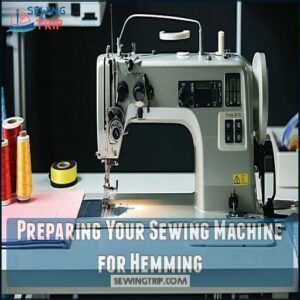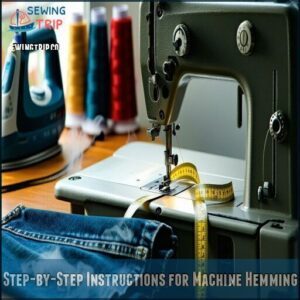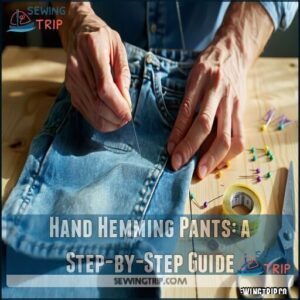This site is supported by our readers. We may earn a commission, at no cost to you, if you purchase through links.

It’s all about folding, pinning, and sewing the fabric at the bottom to create a new hemline. Whether your pants are dragging on the floor or you’re going for a polished look, hemming fixes it.
You’ll need basics like a tape measure, pins, scissors, and either a sewing machine or needle and thread. From dress pants to jeans, different fabrics need slightly different techniques.
Don’t worry—it’s easier than it sounds, and with some care, you’ll nail it. Want to make it flawless? The right techniques make all the difference.
Table Of Contents
- Key Takeaways
- Hemming Pants: What Does It Mean
- Gathering Basic Supplies
- Determining The Right Hem Length
- Pinning and Measuring for Accuracy
- Hemming Pants by Machine
- Hand Hemming Pants: a Step-by-Step Guide
- Troubleshooting Common Hemming Issues
- Fabric Considerations for Hemming
- Perfecting Your Hem for a Flawless Fit
- Frequently Asked Questions (FAQs)
- Conclusion
Key Takeaways
- Hemming pants means adjusting the length by folding and sewing the edges to prevent fraying and create a polished look.
- It gives your pants a custom fit, boosts durability, and enhances your overall outfit’s appearance.
- Use tools like a tape measure, pins, scissors, and a sewing machine or needle and thread for accurate and clean results.
- Different fabrics need specific techniques; for example, delicate fabrics require fine stitching, while heavy materials rely on durable needles and thread.
Hemming Pants: What Does It Mean
Hemming pants means adjusting their length by folding and sewing the fabric edges to guarantee a neat and polished look.
Hemming pants transforms dragging hemlines into a polished fit, boosting confidence with every step.
It helps your pants fit better, prevents fraying, and gives them a professional finish.
Hemming Pants: Definition and Importance
Do your pants drag like they’ve a mind of their own? Hemming pants fixes that by giving them the perfect length through simple length adjustment.
It’s the art of cutting and folding fabric edges, creating a polished appearance while preventing annoying fraying. Whether you’re rescuing jeans or tailoring dress pants, hemming is essential for a neat, customized look. Plus, it’s a basic clothing alteration skill anyone can learn.
Here’s why hemming pants is vital:
- Prevents fraying, extending your pants’ life.
- Customizes length for different body types or styles.
- Transforms oversized pants into a perfect fit with precise pants alteration.
- Adds a polished touch that boosts your confidence.
Shorten pants today and enjoy effortless style. For softer fabrics, consider using hemming tape for a quick, no-sew solution.
Hemming Pants: Purpose and Benefits
Think of hemming pants as a simple way to upgrade your wardrobe.
Hemming pants instantly upgrades your wardrobe with a polished, custom fit that perfectly balances style and comfort.
It’s not just about shortening pants; it’s about creating a polished, customized look that feels like it was made just for you.
This small clothing alteration can work wonders:
- Appearance Improvement: Clean edges prevent fraying, making your pants look fresh and professional.
- Confidence Boost: A custom fit helps you move naturally, showing off shoes like they’re part of the plan.
- Investment Protection: Keep your favorite pants longer by preventing damage.
Hemming pants guarantees fit perfection, turning basic pants into stylish, personalized pieces.
It’s a skill worth mastering!
Gathering Basic Supplies
To hem pants successfully, you’ll need a few basic tools to make the process easy and precise.
Gather items like scissors, thread, needles, pins, a measuring tape, and an iron to guarantee a clean and professional finish.
Essential Tools for Hemming Pants
A smooth hemming pants experience starts with the right tools. You’ll need measuring tools like tape or a hem gauge for accuracy.
Cutting implements, such as sharp fabric scissors, are key for clean edges. Pressing equipment, like an ironing board and iron, guarantees crisp folds.
Stitching supplies, including sturdy needles and a sewing machine, make sewing seamless. Marking tools, like tailor’s chalk, help with guidance.
For marking fabrics, tailor’s chalk works effectively on different materials. Don’t forget a few pins to secure everything neatly.
| Tool Type | Examples | Purpose |
|---|---|---|
| Measuring Tools | Tape measure, hem gauge | For precise length adjustments |
| Cutting Implements | Fabric scissors | Clean, straight fabric edges |
| Pressing Equipment | Iron and board | Crisp, sharp hems |
| Stitching Supplies | Needles, sewing machine | Permanently secure folds |
Fabric Requirements for Hemming
Start by understanding your fabric. Its weight, fiber content, and weave type all affect hemming.
Stretchy fabrics need more handling, like jeans with tough seams.
Here’s how to prep:
- Check the fabric’s stretch factor and pick a thread to match.
- Test stitches on extra scraps first.
- Use sharp sewing scissors for clean cuts.
- Match thread for seamless color blending.
Notions and Materials for Hemming Pants
You’ll need the right gear to nail hemming pants. Stock up on sharp scissors, versatile measuring tools, and precise fabric markers to get started.
Keep a variety of thread types handy for different jobs, and choose needle sizes that match your fabric. Hemming tape is a lifesaver for quick fixes, while pins keep everything in place.
For a seamless finish, consider using specialized options available. Don’t skip ironing—it’s how pros achieve crisp folds.
With these tools, your hemming game will be strong!
Determining The Right Hem Length
Getting the hem length just right guarantees your pants look polished and fit comfortably.
You’ll need to examine your shoe choice, pant style, and how you want the hem to fall for the best results, which involves considering complete concepts such as these to achieve the desired fit.
How Long Should Your Pants Be
You’ve got your supplies, so now it’s time to focus on the perfect hem length. Getting your pants length just right can transform your outfit.
Here’s a quick guide to pant lengths based on your Break Point and Shoe Pairing:
- Full Break – Creates a deep fold above your shoes; ideal for formal looks.
- Slight Break – Leaves a small ripple at the hem for sleek dressing.
- No Break – Hem ends neatly at your shoes; great for sharp, modern styles.
- Cropped – Exposes ankles, perfect for casual settings or current trends.
Wear your shoes, move around, and confirm the pant legs match your Occasion Matters and Personal Style preferences.
Measuring Hem Allowance for Dress Pants and Jeans
Getting the hem allowance right isn’t rocket science. For dress pants, leave 1½ to 2 inches for a polished drape; jeans work best with about ½ inch, thanks to their thicker fabric.
Always measure twice and compare both pant legs for even results. For a professional finish, consider using a serger to prevent fraying.
Refer to the chart for quick tips:
| Fabric Type | Hem Width | Pant Break | Tools Needed | Tips |
|---|---|---|---|---|
| Dress Pants | 1½-2 inches | ½ inch | Measuring tape, pins | Drape enhances finish. |
| Jeans | ½ inch | No break | Scissors, thread | Use heavy-duty needles. |
| Slacks | 1¼-1½ inch | Subtle break | Hem gauge, ruler | Pin for accurate lines. |
| Trousers | 2 inches | 1 inch | Chalk, iron | Keep hemline clean. |
| Casual Pants | 1 inch | Slight break | Hem tape | Ideal for light fabrics. |
Small adjustments make a big difference!
Considerations for Different Pant Styles
Hemming pants isn’t a one-size-fits-all task—you’ll want to tailor the hem to suit the pant style.
Each design has its own ideal look in terms of length adjustments. Here’s how to get it right:
- Slim-fit dress pants look sharp with a slight Trouser Break barely touching the shoe.
- Wide-leg trousers should skim the floor for elegance.
- Jeans with cuffs need extra fabric for those trendy Cuff Styles.
- Cropped styles, whether Casual Hems or formal, should sit just above the ankle.
Careful pants length adjustment keeps every style polished.
Pinning and Measuring for Accuracy
Pinning and measuring guarantee your pants are the perfect length before you start hemming.
With a few tools and careful steps, you’ll avoid uneven hems and save yourself extra work later, which is a key concept to avoid uneven hems.
Pinning The Pair of Pants to The Perfect Length
Start by putting on the pants with shoes, as this guarantees accurate length preferences.
Stand before a full-length mirror to check how the pant legs sit. Fold each leg fabric up to your desired length, and use pins to secure it evenly.
Space the pins about two inches apart to maintain consistent measuring and avoid sagging folds. Walk around a bit to confirm the pants length adjustment feels and looks right.
Misplaced pins can ruin the fit, so recheck the mirror for any uneven spots before hemming pants.
Marking The New Hemline for Precise Measurement
After pinning your pants, use tailor’s chalk or a washable fabric marker for consistent marking.
Trace a clear line following the pins, guaranteeing the new hemline is even all around.
Stand straight in front of a mirror to confirm your pant length aligns with your shoe choice.
Chalk types matter—choose one visible against your fabric.
Don’t forget to double check your hem measurement for accuracy.
Precise fabric marking guarantees perfect hemming pants every time.
Tips for Achieving an Even Hem
Achieving an even hem takes patience and precision, but it’s totally doable! Follow these steps:
- Consistent Measuring: Use a hem gauge to measure the fold evenly around. Eyeballing won’t cut it!
- Accurate Pinning: Pin your pants while wearing them, ensuring the hem sits right where you want.
- Pressing Techniques: A hot iron and careful pressing keep folds crisp and secure.
- Sewing Tips: For smooth stitching, consider a walking foot on your sewing machine—it prevents fabric puckering.
Master these hemming techniques, and you’ll know how to hem pants perfectly!
Hemming Pants by Machine
Hemming pants by machine saves time and gives you a clean, professional finish. With the right setup and a steady hand, you’ll tackle any pair like a pro.
Preparing Your Sewing Machine for Hemming
Let’s get your sewing machine ready for hemming. First, pick the right sewing machine needle and thread type to match your fabric.
Adjust your stitch length and tension settings—aim for smooth, balanced stitches. Use a compatible foot choice, like an all-purpose presser foot, for even fabric feed.
If your pants are narrow, the sewing machine free arm makes stitching tricky areas easier. Baste the hem first to hold everything steady.
Selecting the right needle can impact stitch quality greatly. A well-prepared machine guarantees great results and is crucial for achieving smooth and balanced stitches.
Stitch Options for Different Fabrics
Choosing the right stitch for hemming pants depends on your fabric type and sewing techniques.
Every material needs the proper tools, from stitch length to thread choice and needle size, for the best outcome.
- Straight stitch: Perfect for cotton or lightweight fabrics.
- Zigzag stitch: Best for stretchy materials like knits or yoga pants.
- Blind hem stitch: Offers a nearly invisible finish, ideal for dress pants.
- Overlock stitch: Prevents fraying on raw edges, suitable for medium to heavy fabrics.
- Slip stitch: Great for creating clean, subtle hems by hand.
Adjust tension settings on your sewing machine, especially for delicate or heavy fabrics, ensuring even stitches.
Consider a helpful fabric guide to assist with stitch selection.
For a polished finish, test your stitch on a fabric scrap first.
This attention to detail transforms hems into professional-quality work every time.
Step-by-Step Instructions for Machine Hemming
Ready to hem like a pro? Start by setting up your sewing machine. Make sure it’s threaded and select a suitable stitch, like a blind hem or zigzag.
Iron the fabric to create sharp folds, then press the hem twice for a crisp edge. Guide the fabric through the machine, aligning it with the presser foot—this keeps your hem straight.
Go slow and steady for clean stitches. Once done, give it a final press with the iron. Congratulations, you’ve mastered hemming pants with a polished finish!
Hand Hemming Pants: a Step-by-Step Guide
Hand hemming pants lets you create a neat, polished finish without needing a machine.
With a few basic tools and some patience, you’ll achieve a custom fit that looks professional.
Essential Tools for Hand Hemming
Hand hemming pants requires a few trusty tools.
Start with a sharp needle suited for your fabric and durable, matching thread. Use a thimble to protect your fingers during hand sewing.
A hand hemming gauge and measuring tape keep your lengths accurate. Good lighting matters—spotting every stitch is key.
Creating a Clean and Invisible Hem by Hand
A clean, invisible hem by hand transforms your pants for a polished look.
Follow these steps:
- Choose a fine needle and suitable thread for the fabric.
- Anchor the thread with a hidden knot inside the fold.
Use a tiny blind stitch, catching just one fabric thread to keep it subtle.
Maintain consistent fabric tension to avoid puckering.
Finish by knot hiding inside the hem, creating seamless blind hem pants with a tiny blind stitch.
Tips for Mastering The Hand Hemming Technique
You’ve mastered invisible stitches, now let’s polish your technique.
Focus on thread tension—it’s like tuning a guitar; too tight, and your seams pucker, too loose, and they’ll fall apart.
For knotting techniques, try a double knot to secure your thread—it won’t budge.
Handle fabric gently, especially for slippery or stiff materials, and use practice projects like old pants to refine your skills.
A needle threader saves time, and pressing folds with an iron guarantees crisp edges.
Follow this sewing tutorial to create perfect hand-stitched hems that elevate how you hem pants every time!
Troubleshooting Common Hemming Issues
Hemming isn’t always smooth, and small mistakes can lead to uneven lines or bulky seams.
Knowing how to spot and fix common issues will save you time and guarantee a polished result.
Fixing Lumps and Bumps in The Hem
Struggling with lumps while hemming pants? Don’t sweat it— that’s common! Bumpy hems often come from uneven folding or tension during sewing.
Fix them by gently pressing the fabric with steam and adjusting folds. Use a seam ripper to correct problem areas. For smoother results, reinforce the hem with proper stitching based on fabric density.
- Causes: Uneven folds, tension issues, or fabric thickness.
- Prevention Techniques: Pin carefully, measure twice, double-check folds.
- Pressing Techniques: Steam-iron lightly after each sewing step.
Ensuring Even Hemlines
Getting smooth, even hemlines while hemming pants can feel tricky, but it’s easier with the right techniques.
Start by practicing consistent measurement—double-check your hem length with a hem gauge or ruler. Uneven floors can throw you off, so work on a level surface.
Before sewing, press the fabric using a solid pressing technique; this creates crisp folds that stay in place. Hem gauges help guarantee precise folds, especially for DIY pants hemming.
Use pins to secure the hem and try on the pants to spot uneven areas. For sewing machines, consider a walking foot for heavier fabrics or stretchy material.
Mastering these steps means you’ll know exactly how to hem pants like a pro!
Fabric Considerations for Hemming
When hemming pants, the fabric type plays a huge role in how you approach the task. From delicate silks to stiff denim, knowing your material guarantees a clean, lasting finish.
Delicate Fabrics and Hemming
When hemming pants made of delicate fabrics like silk or chiffon, precision matters.
These materials require a gentle touch to avoid snags or distortions. Hand sewing is often the best approach for lightweight fabrics. Use a fine needle, matching thread, and opt for invisible stitches like slip or blind stitching. Keep your hemming allowance small and double-check measurements to avoid errors.
- Silk hemming: Use a thin needle and thread.
- Chiffon challenges: Prevent puckering with steady stitching.
- Lace considerations: Hand-stitch for seamless blending.
- Satin solutions: Press lightly to avoid marks.
Heavy Fabrics and Hemming
Working with heavy fabrics like denim, leather, or upholstery can feel intimidating, but it’s all about the right tools and technique.
For denim hemming or hemming jeans, you’ll need a heavy-duty needle and sturdy thread—contrasting colors add a bold, stylish touch.
Leather hems work best with matching threads and shorter stitch lengths, ensuring a sleek finish.
Corduroy challenges? Use a sturdy needle and longer stitches to avoid puckering.
Don’t forget canvas considerations, as these thicker materials require careful trimming to prevent bulk.
Always adjust your sewing machine’s tension and test on scraps first. Take it slow, and your heavy hems will look flawless!
Fabric Type and Hemming Techniques
In the context of hemming pants, matching your fabric choice with the right sewing techniques is key.
Each fabric type demands specific stitch selection and edge treatments for a flawless hem finish.
- Delicate fabrics like chiffon thrive with rolled hems and fine threads to avoid bulk.
- Heavy fabrics like denim need sturdy machine sewing with heavy-duty thread.
- Stretch fabrics call for hand stitching or zigzag stitches to maintain flexibility.
The right technique variation transforms your efforts from "just okay" to professional quality!
Perfecting Your Hem for a Flawless Fit
Getting a hem just right takes patience and close attention to detail.
By focusing on even stitching, clean edges, and a polished finish, you’ll guarantee your pants look professional and fit perfectly.
Ensuring an Invisible Hem
Mastering an invisible hem takes finesse and technique.
A blind stitch is essential—it hides within the fabric, keeping your finish seamless.
Match thread to your fabric for a unified look.
Pressing techniques matter too: over-ironing creates harsh lines, so go gently.
| Technique | Visibility | Durability |
|---|---|---|
| Blind Hem Pants | Invisible | High |
| Bias Binding | None | Moderate |
| Machine Hem Pants | Subtle | High |
| Pinked Edges | Fair | Low |
| Seam Finishing | Minimal | Moderate |
Maintaining an Even Hem Allowance
How do you keep your hem allowance consistent? Precision is everything when hemming pants!
Use a hem gauge to measure evenly, adjusting folds for accuracy. Uneven hems can make your pants look unbalanced, so take time to align edges.
- Trim excess fabric carefully for smooth finishes.
- Mark with a hem gauge for pinpoint consistency.
- Pin and press folds to avoid fabric creep.
Pressing importance? Always iron each step to lock in shape. With consistent measurement and attention to detail, your hem will look flawless!
Finishing The Hem With a Professional Touch
A polished hem sets your custom pants apart.
Start by pressing the hem with an iron—this step guarantees a crisp, flat finish. Use appropriate pressing techniques based on fabric type. For example, denim pairs well with a topstitch, while silk benefits from a blind hem stitch.
Pay attention to thread selection for a seamless look, and practice edge finishing to prevent fraying. To avoid fraying, consider employing zigzag stitching methods.
Conceal seams for a professional touch, especially when using a sewing machine. Remember, hemming pants isn’t just functional—it’s about achieving a flawless fit that enhances your pants making skills.
Frequently Asked Questions (FAQs)
How do you Hem pants?
It’s funny how a simple fold and stitch can transform pants.
To hem, you cut excess fabric, fold the edge twice, press, then sew.
Measure carefully and iron for a clean, sharp finish.
Why do pants have HEMS?
Pants have hems to keep the fabric edges neat and prevent fraying.
They give pants a finished, professional look while ensuring durability.
Without hems, your pants would wear out faster and look unpolished.
What is a hem on pants?
Imagine your jeans fraying at the bottom—annoying, right?
A hem is the folded, sewn edge at the pant leg’s end that keeps fabric from unraveling, giving your pants a neat, finished look.
How do you know if a pair of pants have a hem?
You’ll know pants have a hem if their bottom edges are neatly folded and sewn in place.
Look for a clean, stitched line inside or outside the cuff that prevents fraying and adds structure.
How do I choose the best Hemming pants?
Choosing the best hemming method is like tailoring a perfect story—measure twice for accuracy, pick tools that suit your skill level, and match thread to fabric.
Practice on scraps first to avoid surprises, and remember to match thread to fabric.
Why do you need a pant hemming machine?
You need a pant hemming machine for faster, cleaner, and precise hems.
It saves time, guarantees durability, and gives a professional finish.
It’s perfect for sewing enthusiasts or those regularly tailoring pants.
How should pants be hemmed?
Hemming pants is like giving them a custom haircut.
Start by measuring the desired length, trim excess fabric, and fold neatly.
Secure with pins, press the edge, and sew evenly for a polished, finished look.
Is it worth hemming pants?
It’s absolutely worth hemming pants.
Properly hemmed pants fit better, look polished, and last longer.
Whether you DIY or go to a tailor, adjusting the length guarantees comfort, style, and confidence in your outfit.
What does it mean to hem pants?
Hemming pants means adjusting their length by folding and sewing the edges to create a clean, finished look.
This prevents fraying, guarantees a perfect fit, and keeps your pants looking polished and stylish.
Is hemming pants expensive?
The cost of hemming pants depends on whether you do it yourself or hire a tailor.
DIY saves money but requires time and tools.
Professionals generally charge $10-$50, depending on fabric, complexity, and location.
Conclusion
Think of hemming pants like giving them a custom haircut—it’s all about the perfect length.
With the right tools, a steady hand, and some patience, you can tailor your pants to fit just right.
Whether you’re using a machine or hand stitching, practice makes perfect.
Don’t forget to measure carefully, pin evenly, and choose a technique that suits your fabric.
Hemming isn’t hard, and nailing the right fit gives your pants a clean, polished look.
- https://tmtailor.com/blogs/news/how-to-hem-your-pants-at-a-tailor-a-complete-guide?srsltid=AfmBOooPkyEybj9zXFU1wBLuSAgCs_8-FZZ3nzlRmO5j9rp_rPZZJMUV
- https://alterations-express.com/2022/09/06/pant-hems-everything-you-need-to-know/
- https://sewcanshe.com/how-to-hem-pants/
- https://www.youtube.com/watch?v=S4riD5a_vKg&pp=0gcJCdgAo7VqN5tD
- https://www.masterclass.com/articles/how-to-hem-your-own-pants



















